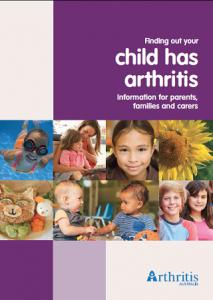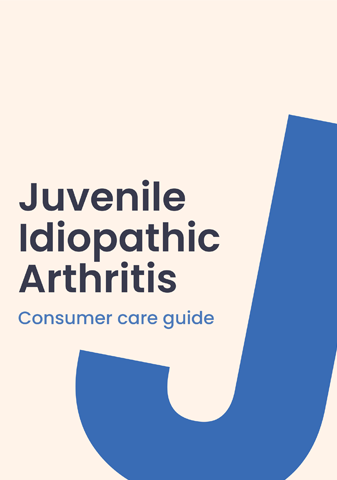What is Juvenile idiopathic arthritis (JIA)?
Juvenile idiopathic arthritis (JIA) is the name given to a number of types of arthritis that occur in children. The name comes from:
- Juvenile: referring to children under the age of sixteen years.
- Idiopathic: meaning the cause is unknown.
- Arthritis: conditions that cause joint pain and inflammation.
What are the main symptoms?
Your child may have experienced one or more of these symptoms:
- joint pain, swelling, tenderness, stiffness, redness and warmth
- fatigue (tiredness and lack of energy), fevers, loss of appetite or weight, and generally feeling unwell
- skin rashes
- inflammation of the eyes (uveitis) and other organs of the body in some forms of the disease.
Any joint in the body may become inflamed but the joints most commonly affected are the knees, hips, hands and feet. Any number of joints might be affected from just one to several.
JIA symptoms can fluctuate – meaning they may vary from day to day, week to week. There will be times when symptoms are worse – these are called ‘flares’ – and then times when they are in remission.
The outlook for children with JIA is usually very positive. The good news is that most children with JIA will not have active symptoms by the time they become adults.
What causes it?
The causes of arthritis in children are not yet fully understood.
We do know that JIA is an autoimmune condition. This means the body’s immune system (its protective mechanism against infection) starts to mistakenly attack healthy cells of the body. This happens for reasons we don’t yet understand, possibly after being triggered by a virus or bacterial infection. The immune system fails to ‘turn off’ when the infection has been cleared producing ongoing joint inflammation called JIA. The immune system mistakenly attacks cells in the connective tissues, including the lining of the joints (synovium). JIA can also affect connective tissues in other parts of the body.
JIA is not an infectious condition so it cannot be spread from one child to another.
How is it diagnosed?
There is no single test to diagnose JIA. Instead, it involves a number of steps. These may include:
- detailed health and medical histories of your child and their biologically related family members (where known)
- physical examination of affected joint/s
- laboratory tests e.g. blood tests (see next page)
- other tests such as X-rays, ultrasound and/or scans of the joints
- eye tests
The results of these tests will help in confirming a diagnosis of JIA, or rule out any other possible causes for the symptoms your child is experiencing.
Sometimes all of the test results will be normal. This does not necessarily mean your child does not have JIA – it just means that the tests will need to be repeated, possibly when your child has symptoms.
If your doctor suspects JIA, your child should be referred to a rheumatologist (ideally a paediatric rheumatologist who specialises in children with arthritis) who would confirm the diagnosis and start treatment.
Reaching a diagnosis can take time due to the fluctuating nature of the condition. The ‘waiting period’ can be a very anxious and frustrating time. These feelings are understandable, but it is important to keep on with the process until the diagnosis is made. Once JIA is diagnosed, your child can be started on treatment to manage symptoms and to reduce potential damage.
What are the main types of JIA?
There are five main types of JIA each with its own specific set of symptoms. These main types are :
- Oligoarthritis (from ‘oligo’ meaning few). This is the most common type of JIA and occurs when up to four joints are affected, usually the large joints such as the knees and ankles. Children with oligoarthritis may develop uveitits (inflammation of the eye).
- Polyarticular (from ‘poly’ meaning many). This type involves five or more joints, with the same joints on each side of the body affected, including fingers, toes, wrists, ankles, hips, knees, neck and jaw.
- Systemic onset JIA. (Also known as ‘Still’s disease’)This is the least common type of JIA. It not only affects the joints, but causes widespread inflammation with high fevers, rashes, swollen glands, aching limbs and fatigue. It can be difficult to diagnose because early symptoms can be confused with other childhood diseases such as measles or glandular fever.
- Enthesitis-related arthritis (ERA). Enthesitis refers to inflammation of the ligaments and tendons which are attached to bones. This type of JIA causes pain and inflammation in the tendons and tissues around the joints rather than the joints themselves. It most commonly affects the spine, heel, hips, knees and ankles.
- Psoriatic arthritis. This type of JIA can affect any number of joints and is usually associated with the scaly skin rash of psoriasis. Like other forms of JIA there is a risk of developing uveitis (eye inflammation).
What will happen to my child?
Every child’s JIA is different and responds differently to treatment. It is very difficult to predict how long JIA will last, its severity or how often it might swing between being almost symptom-free to quite disabling.
The treatments for JIA are constantly improving and the good news is that many children with JIA who receive early diagnosis and good treatment, both during and between flares, will grow up without any lasting effects of their arthritis.
There is still not cure for JIA but many children go into remission, meaning symptoms disappear for long periods, sometimes forever. For some, JIA can cause longer-term problems, especially if they do not receive early diagnosis and treatment.
How is JIA managed?
Early diagnosis and active, long-term management provides the best chance for a positive outcome for your child.
Management of JIA will be specific to your child, depending upon:
- which type of JIA they have
- how/where it is affecting them – how many joints, which joints, which non-joint symptoms e.g. uveitis (eye inflammation) are present
- how active the condition is – whether it is ‘flaring’ or in remission
- how well your child tolerates and responds to the medicines prescribed to treat the condition and other management interventions.
The management of your child’s JIA will need to be monitored closely and changes made from time to time to be responsive to any issues as they arise.
Any management plan will need to involve both medical and physical therapies to ensure that all aspects of your child’s health, growth and development are monitored.
Remember, your child’s body is still growing so they need to do the things that all children do to grow big and strong such as exercise, have a healthy diet and lots of fresh air and sunshine. Like all children, they also need lots of fun and laughter.
Who can help to manage my child’s JIA?
To achieve the best possible health outcomes, the management of your child’s JIA will involve a team effort over a long period of time. It is important that you and your child are at the centre of the care team, involved in all aspects of health management and decision making. This means having open, honest discussions with team members and asking any questions that you have along the way.
Depending on the child’s individual needs, the team may include:
- Rheumatologist (paediatric rheumatologist if available)
- Paediatrician
- General practitioner (GP)
- Rheumatology nurse (if available)
- Physiotherapist
- Occupational therapist (OT)
- Ophthalmologist (specialist eye doctor)
- Podiatrist, Orthotist
- Dentist
- Pharmacist
- Child psychologists/Counsellors/ Play therapists/Social workers
- Teachers and school support staff
- Other family members – siblings, grandparents and carers.
Developing a relationship with members of the health care team is vitally important. Remember that you know your child best and this information will be invaluable for members of the health care team.
What treatments are there for JIA?
There are many different treatments available for JIA.
What works for one child may not work for another and finding the right treatment for your child can involve a process of trial and error. While this can be frustrating for all involved, it is important that you stick with the process to ensure that your child gets the best possible treatment for their particular type of arthritis.
The overall treatments used for JIA aim to:
- prevent or slow damage to joints and/or progression of the illness
- reduce symptoms including inflammation, stiffness and pain
- assist your child’s normal growth and development, and ensure that they are able to get back to their usual activities and lead the most normal life possible.
Medicines will play a major role in the management of JIA. As a parent you may feel anxious about the prospect of your child taking these medicines. This is natural and understandable but they are very necessary for the best long-term outcomes for your child. It is important that you have the opportunity to discuss any worries or questions that you have about the medicines with the prescribing doctor.
See Medicines for more information.
Managing pain
Pain is a very common symptom of JIA, even when children are on therapies that are effectively treating their underlying condition.
High levels of pain can result in children with JIA being less physically active and may reduce their participation in school, social and family activities.
It can also result in sleep disruption and poor sleep quality, which in turn can cause daytime fatigue, reduced mood and increased sensitivity to pain, essentially creating an ongoing pain cycle.
A range of interventions, including medicines, use of hot and cold treatments, relaxation and distraction techniques, deep breathing, massage, gentle stretching and exercise can assist in relieving pain.
Members of the JIA healthcare team can offer suggestions and interventions that actively address your child’s pain. A comprehensive, multidisciplinary approach will provide you and your child with techniques and skills aimed at limiting the impact of pain on your child’s physical and psychological health and their social and educational development.
Physical activity
Physical activity is essential for good health and well-being in all children, and even more so for children with JIA. It assists to:
- relieve stiffness, improve joint mobility and range of movement
- maintain/enhance muscle and bone strength
- improve physical function and independence.
It is important that your child remains as active as possible, every day. This may mean finding physical activities or sports that they enjoy but that do not cause too much discomfort. Generally, non-contact sports will be best for children with JIA to reduce the risk of joint injury or damage. Low impact activities such as cycling, yoga and swimming are ideal as they do not place too much stress or strain on joints.
In addition your child should have an individually tailored exercise program that they do every day. Your child’s physiotherapist or exercise physiologist can advise you on suitable exercises.
Download the Juvenile arthritis information sheet
For more detailed information on managing and living with JIA, download our Finding out your child has arthritis and/or the Juvenile Idiopathic Arthritis Consumer care guide booklet.

